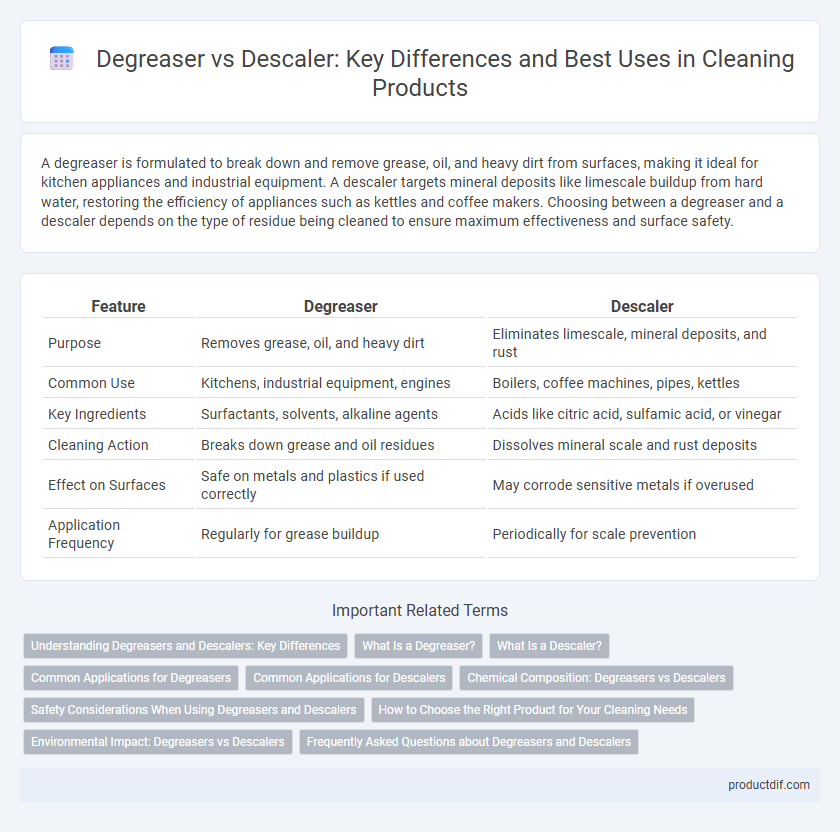A degreaser is formulated to break down and remove grease, oil, and heavy dirt from surfaces, making it ideal for kitchen appliances and industrial equipment. A descaler targets mineral deposits like limescale buildup from hard water, restoring the efficiency of appliances such as kettles and coffee makers. Choosing between a degreaser and a descaler depends on the type of residue being cleaned to ensure maximum effectiveness and surface safety.
Table of Comparison
| Feature | Degreaser | Descaler |
|---|---|---|
| Purpose | Removes grease, oil, and heavy dirt | Eliminates limescale, mineral deposits, and rust |
| Common Use | Kitchens, industrial equipment, engines | Boilers, coffee machines, pipes, kettles |
| Key Ingredients | Surfactants, solvents, alkaline agents | Acids like citric acid, sulfamic acid, or vinegar |
| Cleaning Action | Breaks down grease and oil residues | Dissolves mineral scale and rust deposits |
| Effect on Surfaces | Safe on metals and plastics if used correctly | May corrode sensitive metals if overused |
| Application Frequency | Regularly for grease buildup | Periodically for scale prevention |
Understanding Degreasers and Descalers: Key Differences
Degreasers are specialized cleaning agents designed to break down and remove grease, oil, and heavy grime from surfaces, making them essential in kitchens and industrial settings. Descalers target mineral deposits, such as limescale and calcium buildup, commonly found in appliances like kettles, boilers, and coffee machines. Understanding the chemical composition and application areas of degreasers versus descalers helps optimize cleaning efficiency and prolong equipment lifespan.
What Is a Degreaser?
A degreaser is a powerful cleaning product designed to break down and remove grease, oil, and heavy dirt from surfaces such as kitchen appliances, automotive parts, and industrial machinery. It contains strong solvents or surfactants that emulsify oily residues, making them easier to wipe or rinse away. Unlike descalers, which target mineral deposits and limescale, degreasers focus specifically on eliminating stubborn grease buildup for thorough surface cleaning.
What Is a Descaler?
A descaler is a cleaning product specifically designed to remove mineral deposits such as limescale, calcium, and rust buildup from surfaces exposed to hard water. It is commonly used on appliances like kettles, coffee machines, and washing machines to restore efficiency and prolong lifespan. Unlike degreasers that target oily residues, descalers chemically break down inorganic scales using acidic agents like citric acid or sulfamic acid.
Common Applications for Degreasers
Degreasers are primarily used to remove oils, grease, and heavy grime from surfaces such as kitchen appliances, automotive engines, and industrial machinery. They are essential in food processing plants for cleaning conveyor belts and equipment to maintain hygienic conditions. In automotive maintenance, degreasers efficiently clean engine parts and tools, ensuring optimal performance and longevity.
Common Applications for Descalers
Descalers are commonly used to remove mineral deposits and limescale build-up in appliances such as coffee makers, kettles, dishwashers, and water heaters. They are essential for maintaining the efficiency and lifespan of plumbing systems, boilers, and HVAC units by dissolving calcium and magnesium buildup. Regular descaler application prevents clogging and enhances the performance of water-related equipment in residential and commercial settings.
Chemical Composition: Degreasers vs Descalers
Degreasers typically contain surfactants, solvents, and alkaline agents like sodium hydroxide to break down grease and oils, making them highly effective for kitchen and industrial cleaning. Descalers primarily consist of acidic compounds such as hydrochloric acid, sulfamic acid, or citric acid that dissolve mineral deposits like calcium carbonate and lime scale from surfaces. Understanding these chemical compositions helps select the right product for removing organic grease versus inorganic mineral buildup.
Safety Considerations When Using Degreasers and Descalers
When using degreasers and descalers, it is crucial to follow safety guidelines such as wearing protective gloves and ensuring proper ventilation to avoid skin irritation and inhalation of harmful fumes. Degreasers often contain strong solvents that can cause respiratory issues and chemical burns, while descalers typically involve acidic formulas requiring careful handling to prevent corrosion and eye damage. Always read product labels and safety data sheets to use these cleaning agents effectively and minimize health risks.
How to Choose the Right Product for Your Cleaning Needs
Choosing between a degreaser and a descaler depends on the type of residue and surface involved; degreasers are formulated to break down oily, greasy buildup in kitchens, while descalers target mineral deposits like limescale in bathrooms and appliances. Consider the specific cleaning challenge--use degreasers for grease on stovetops or exhaust hoods and descalers for removing calcium or lime buildup in kettles, coffee machines, and pipes. Selecting the right product enhances cleaning efficiency, prevents surface damage, and ensures long-term maintenance of household or industrial equipment.
Environmental Impact: Degreasers vs Descalers
Degreasers often contain petroleum-based solvents and surfactants that can pose risks to aquatic life and contribute to water pollution if not properly disposed of. Descalers typically use acids like citric or sulfamic acid, which are biodegradable and generally have a lower environmental footprint when diluted correctly. Choosing biodegradable formulations and responsible disposal methods significantly reduces the ecological impact of both degreasers and descalers.
Frequently Asked Questions about Degreasers and Descalers
Degreasers effectively remove grease, oil, and heavy dirt from surfaces like kitchen appliances and industrial equipment, while descalers target mineral deposits and limescale buildup often found in kettles and boilers. Frequently asked questions include how to choose the right product based on surface type and cleaning requirements, proper usage instructions to avoid damage, and safety precautions due to the chemical composition of both degreasers and descalers. Understanding the distinct purposes and chemical properties ensures optimal cleaning performance and prolongs the lifespan of appliances and machinery.
Degreaser vs Descaler Infographic

 productdif.com
productdif.com